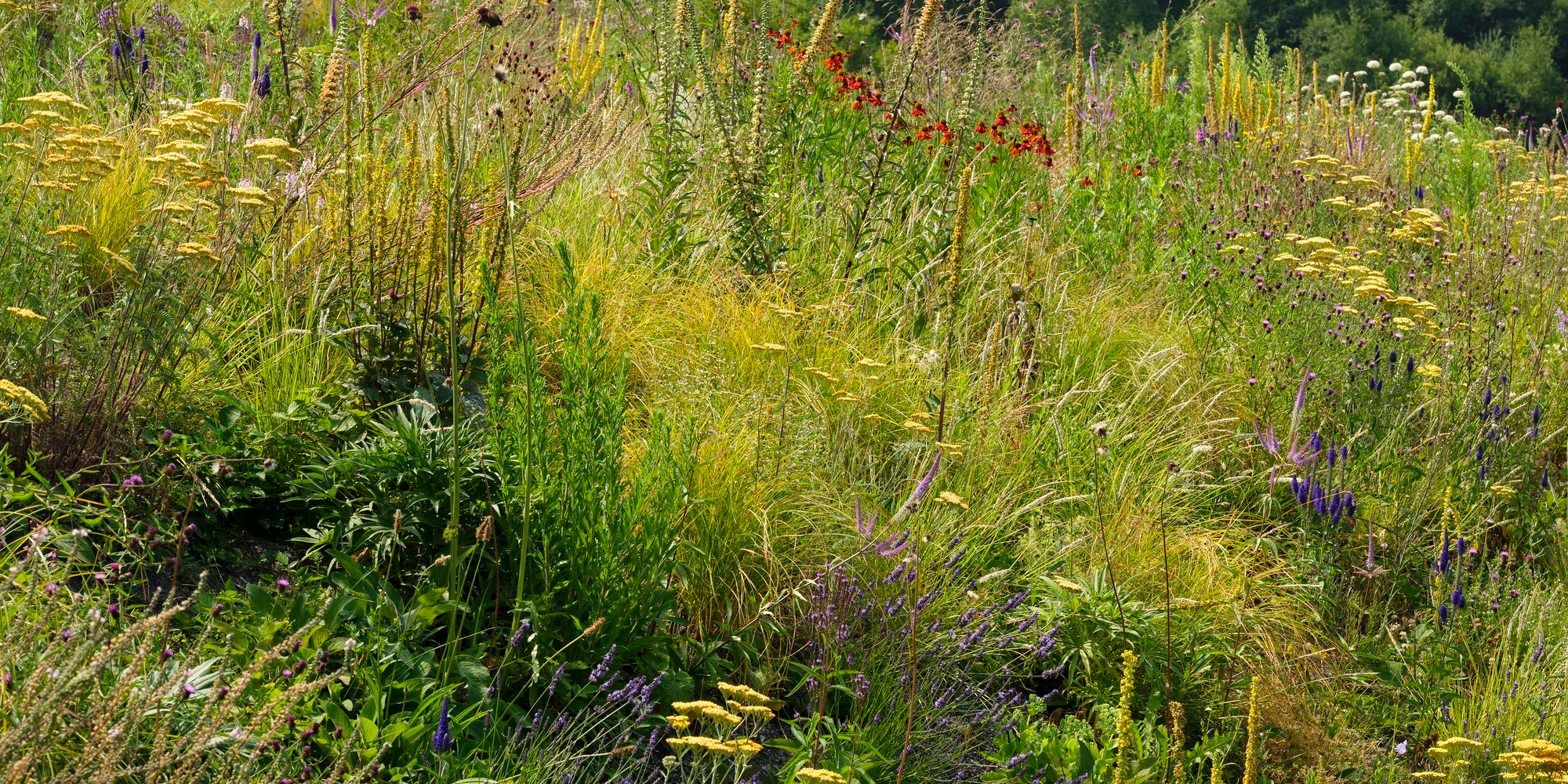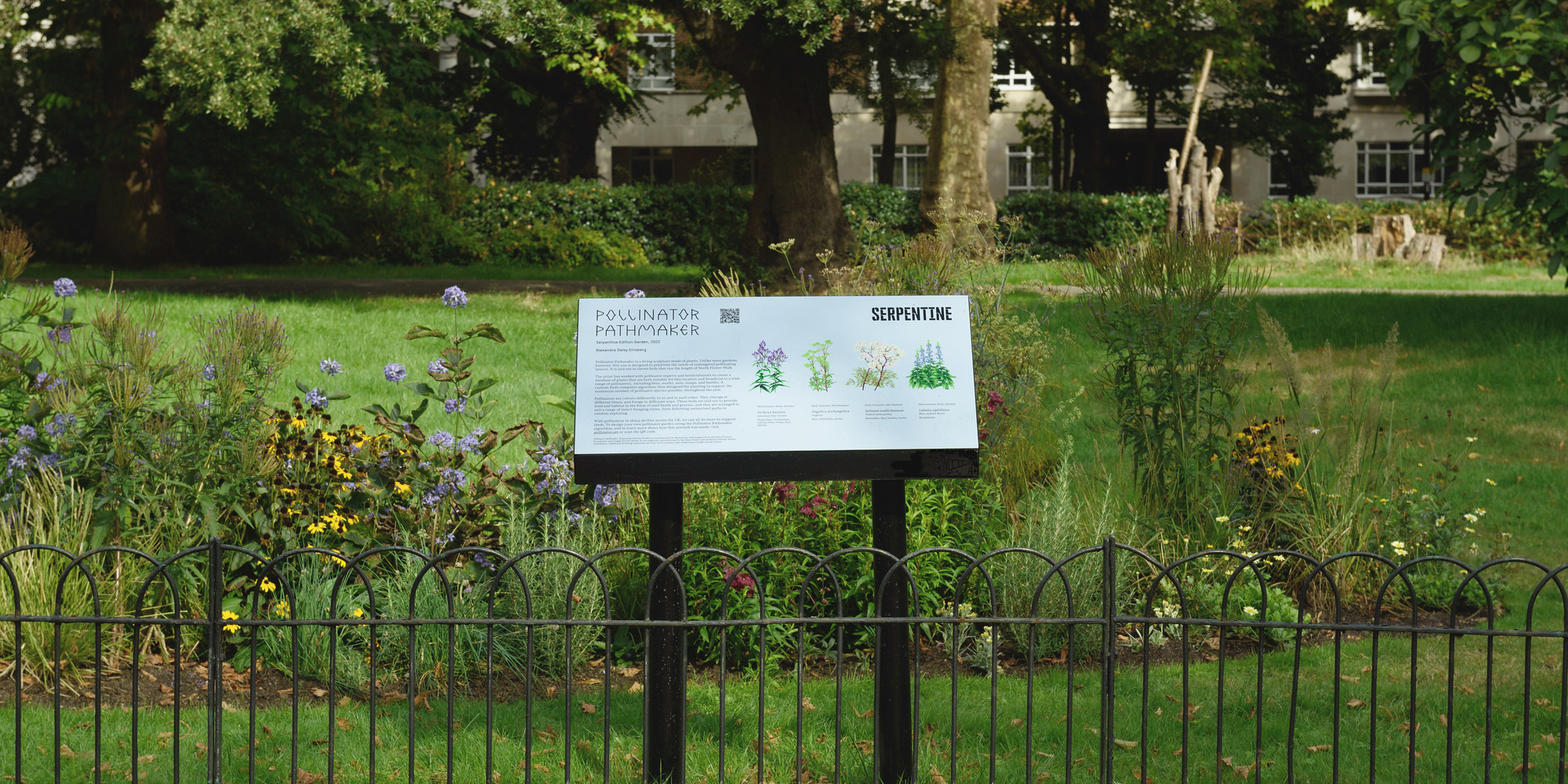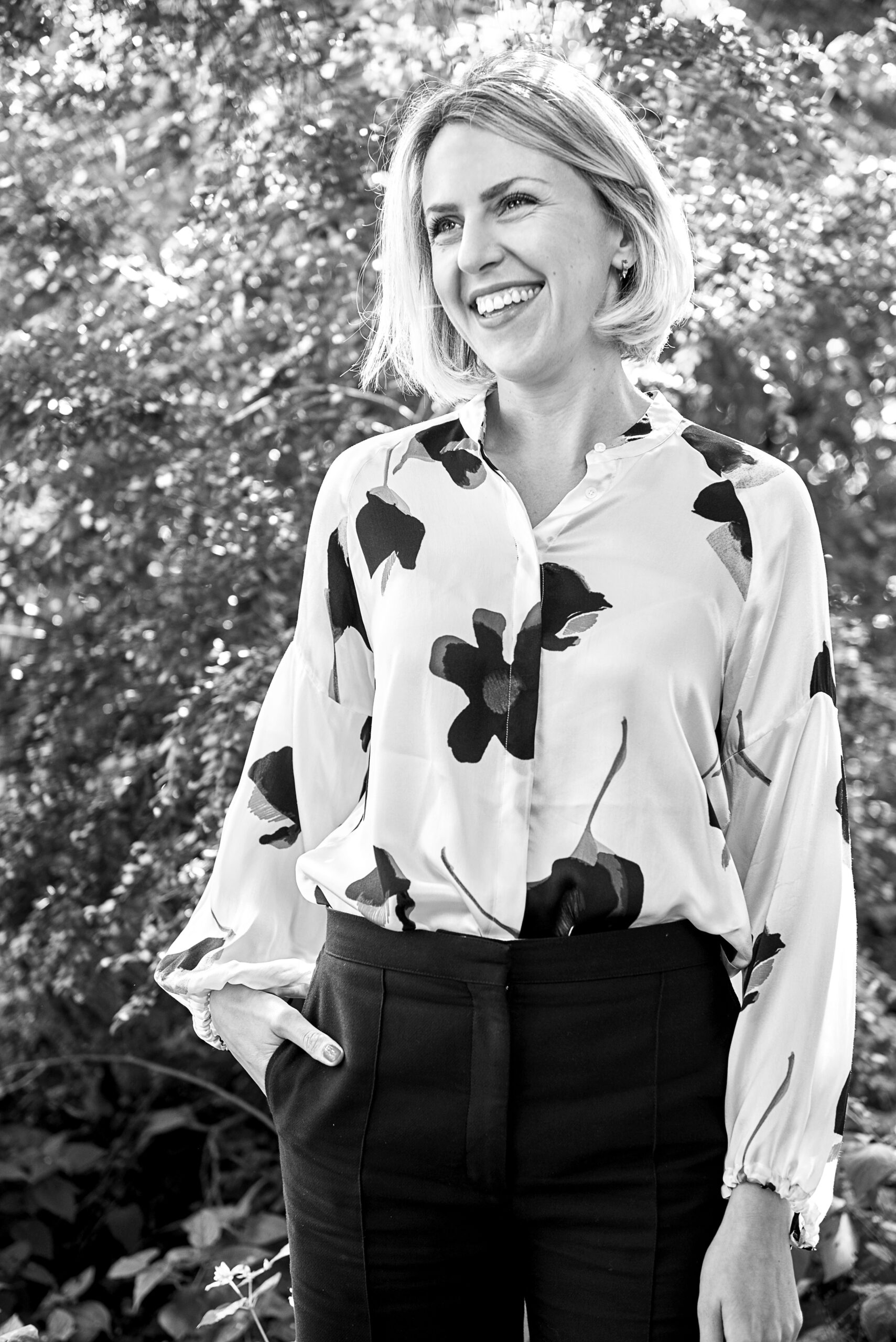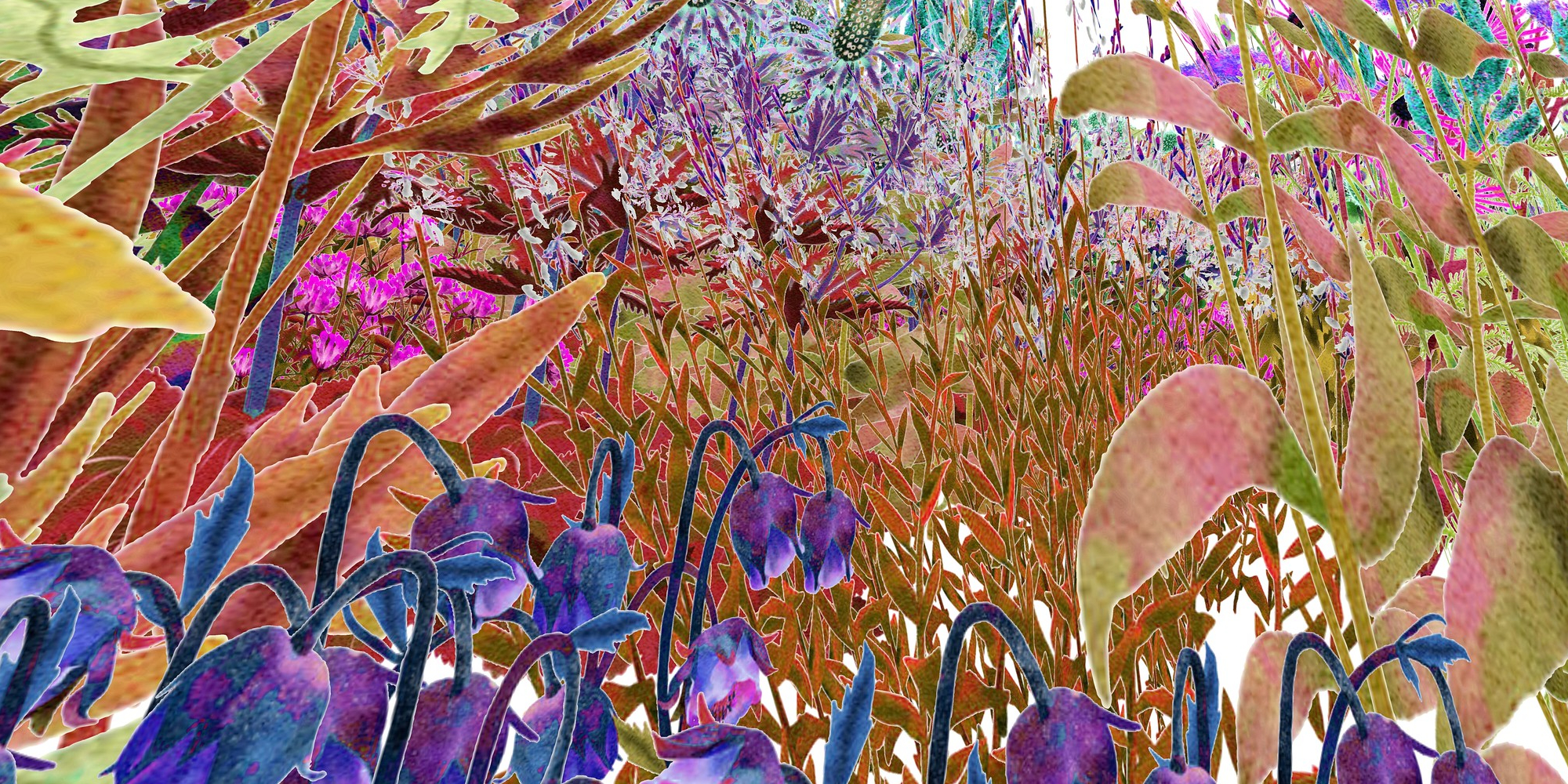A “living sculpture of plants,” Pollinator Pathmaker was designed to prioritize the needs of endangered pollinating insects over those of humans. The ongoing artwork asks its visitors* to look at the world from the perspective of plants and pollinators. Pollinators, which include animals such as bees, butterflies, bumblebees, birds, and bats, play a crucial role as they transfer pollen from the male organs of a flower to the female organs. This enables fertilization and the production of fruits and seeds. At the same time, it is a call to action to address the dramatic decline of pollinating insects over the past 40 years due to habitat loss, pesticides, invasive species and climate change.
What was the inspiration and vision behind the “Pollinator Pathmaker” artwork? How did it evolve?
Alexandra Daisy Ginsberg: Pollinating insects — bees, wasps, moths, butterflies, beetles and other species – are essential for many plants to reproduce. But human-made habitat loss, pesticides, invasive species, and climate change are causing a terrifying decline in insect populations.
I was originally commissioned to make a sculpture about pollinators by the Eden Project, Cornwall, in 2020. Given the jeopardy insects face, I wanted to make art for pollinators, not about them: to create a living artwork that is climate positive.
Pollinators experience the world very differently from us. Different species see colours differently from us and from each other: for example, bees can’t see red but they can see UV. What does a garden look like from their point of view? We breed garden plants for our aesthetic preferences, whether smell, colour, or abundance of petals. But these “features” are for our enjoyment, and as a result, plants may produce less nectar and pollen, or these resources become inaccessible to their pollinators. Humans also design gardens as isolated spaces for themselves. But gardens form interconnected networks across landscapes. I want to make artworks that are empathetic to the tastes of pollinators, not human tastes.
Pollinator Pathmaker explores many questions at the heart of my practice: Can art be enjoyed by the more-than-human? What is the role of art in the ecological crisis: can it give agency? What should land art be in 2023? Can we upend “value” in art from scarcity to abundance? How can digital art be more sustainable?
Is it possible for humans to make altruistic technologies, or is everything that we create ultimately for our own benefit?
Alexandra Daisy Ginsberg
How are science, technology, and art connected in the project?
Alexandra Daisy Ginsberg: I worked with pollinator scientists and experts, horticulturists and an AI scientist to inform the design of my Pollinator Pathmaker empathy tool, an algorithm that generates unique planting schemes that support the greatest diversity of pollinator species. It’s an attempt to make what I call an “altruistic algorithm”. It optimises a number of overlapping parameters such as pollinator type and blooming period, and also accommodates two different foraging styles.

How can the knowledge and experience gained through the project help stop the decline of pollinator insects and combat climate change? And how can the project help change our understanding of the relationship between humans and nature and inspire us to live more sustainably?
Alexandra Daisy Ginsberg: Alexandra Daisy Ginsberg: Pathmaker won’t solve the pollinator crisis or climate emergency. It is a science-based artwork that I want to use to give people a sense of agency. I feel immobilised not only by ecological panic but also by my own hypocrisy as I engage in destructive activities every day as a consumer, rather than fighting back.
Since the true audience of the artwork is pollinating insects, humans become the caretakers of the artwork, not its consumers. It is not a representation of nature; the interaction between pollinators and plants is the art. Spending time looking more carefully, slowing down, learning to nurture ecosystems, and investing time to take care is empowering and essential.
My ambition is to make the world’s largest climate-positive artwork. The artwork is structured around large commissioned Editions and DIY Editions. Three large Editions have now been planted: at the Eden Project, Cornwall, UK, for the Serpentine in Kensington Gardens, London, and the first international edition is now carpeting the forecourt of the Museum für Naturkunde Berlin, commissioned by the LAS Art Foundation.
As Pollinator Pathmaker enters new climatic regions, we create new “Plant Palettes” with local expert advisors. These curated databases consists of locally appropriate plants (rather than natives). Each plant is chosen for the pollinator species it supports, the blooming time, the conditions it can be planted in, and its compatibility with the palette as a whole. Each time the algorithm runs, it selects and arranges a subset of suitable plants for the schemes it generates to support the maximum number of pollinator species possible. The regional Plant Palettes are added to www.pollinator.art, and there, anyone can generate instructions to fabricate (plant) their own personal DIY Edition. The investment they make is not in the digital artwork, but in the plants and time and space they contribute.
It presents an alternative way of thinking about an artwork: here, the value is in abundance, not scarcity. Normally the smaller an art edition, the greater its value. Pollinator Pathmaker is unlimited: the more individual editions created – big and small, planted close to each other – the greater the flourishing of each. The large commissioned Editions act as local catalysts. Visitors experience the artwork and are invited to plant their own DIY Edition nearby, to support mutual flourishing. The provocation is that at some point Pollinator Pathmaker becomes one interconnected artwork, rather than many individual ones.
We may have already made the world’s largest climate-positive artwork. But how do you measure this? I want to explore this further as I want to make art in a more sustainable way.

Can you tell us more about your plans for the future of the project?
Alexandra Daisy Ginsberg: We’re working now on the first rooftop Edition and exploring commissions for new countries. I want to create more regional plant palettes to add to the DIY Edition tool on pollinator.art. We get so many requests from around the world to add more regions! Creating each palette is a large research project in itself as the database of around 150 plants must suit all different garden conditions for the region, and then I paint each plant in multiple seasons for the visualisation tool. For example, LAS commissioned the Continental Europe palette, so that users over a larger swathe of Europe can join in.
I also want to expand the scientific field study into the algorithm and its impact on functional biodiversity. The first study has been conducted by Dr Christopher Kaiser-Bunbury at the University of Exeter on the Eden Project Edition garden, comparing it to regular pollinator-friendly planting and a wildflower meadow. We’re applying for grants to do further research together.
I’m also exploring one of the questions behind Pollinator Pathmaker: can digital art be presented more sustainably, without screens? The planted editions are digital artworks, printed in flowers. I’m now blowing up my digital paintings into large-scale tapestries, spanning the seasons, to shrink humans to the scale of pollinators, and think about time-based media without screens. After all, a garden exists in time, not just in space.
Anyone who wants to see the artwork for themselves will have the opportunity to do so at this year’s Ars Electronica Festival. The festival highlights can be found here.

Alexandra Daisy Ginsberg (GB) is a multidisciplinary artist examining our fraught relationships with nature and technology. Her work investigates the human impulse to “better” the world, exploring artificial intelligence, synthetic biology, conservation, biodiversity, and evolution. Ginsberg won the London Design Medal for Emerging Talent (2012), the Dezeen Changemaker Award (2019), and Prix Ars Electronica Honorary Mention, Interactive Art for Machine Auguries (2020). She has exhibited internationally, including at MoMA New York, the Museum of Contemporary Art, Tokyo, the Centre Pompidou, the Royal Academy, and the Toledo Museum of Art. In 2022, Ginsberg launched her climate-positive artwork Pollinator Pathmaker, with commissions at the Eden Project (Cornwall) and Serpentine (London). In 2023, Ginsberg launches the first international Edition with LAS Art Foundation (Berlin).
